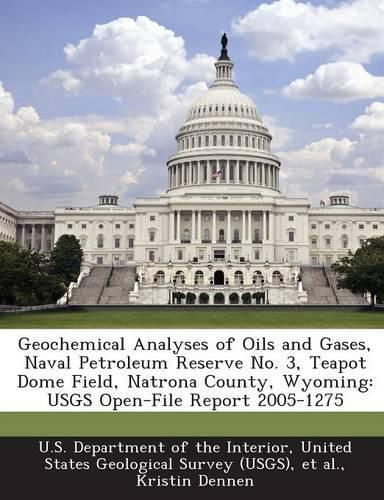Readings Newsletter
Become a Readings Member to make your shopping experience even easier.
Sign in or sign up for free!
You’re not far away from qualifying for FREE standard shipping within Australia
You’ve qualified for FREE standard shipping within Australia
The cart is loading…






Initial results of this study confirm the presence of two different oil compositions at the Teapot Dome field, 1) oils from Cretaceous reservoirs and 2) oil from the Pennsylvanian Tensleep Sandstone reservoir. Cretaceous oils are less mature, show more evidence of secondary biodegradation and have a mixed terrestrial and marine kerogen source. Moreover, Cretaceous oils can be separated into three different groups, Upper Cretaceous sandstone reservoirs, Upper Cretaceous shale reservoirs, and lower Cretaceous Sandstone reservoirs. The Upper Cretaceous sandstone reservoirs, the Shannon Sandstone and the Second and Third Wall Creek Sands show differences related to gas production, gas-reinjection effects and steam flood effects. The Pennsylvanian Tensleep oil is more mature, less biodegraded, has higher a sulfur content, shows evidence of water washing, and has a marine kerogen source. Hydrocarbon degradation in the Cretaceous sandstone reservoirs varies along the length of the highly fractured Teapot Dome anticlinal structure–the main trap for hydrocarbons in the Teapot Dome field–which is divided into two domes by an east-west trending fault system. The least degraded samples occur in the southern dome, where reservoirs are deeper and in general, the most degraded are in the northern dome where stratigraphically equivalent reservoirs are shallower. The Pennsylvanian Tensleep oil does not show any variation between the Teapot Dome field and the adjacent Salt Creek field to the north. Molecular and isotopic composition of gases indicates thermogenic gases may have been altered by two different microbial processes, methanogenesis and secondary bacterial alteration. Also, there are two different types of ozocerite, with possibly two different histories of emplacement.
$9.00 standard shipping within Australia
FREE standard shipping within Australia for orders over $100.00
Express & International shipping calculated at checkout
Initial results of this study confirm the presence of two different oil compositions at the Teapot Dome field, 1) oils from Cretaceous reservoirs and 2) oil from the Pennsylvanian Tensleep Sandstone reservoir. Cretaceous oils are less mature, show more evidence of secondary biodegradation and have a mixed terrestrial and marine kerogen source. Moreover, Cretaceous oils can be separated into three different groups, Upper Cretaceous sandstone reservoirs, Upper Cretaceous shale reservoirs, and lower Cretaceous Sandstone reservoirs. The Upper Cretaceous sandstone reservoirs, the Shannon Sandstone and the Second and Third Wall Creek Sands show differences related to gas production, gas-reinjection effects and steam flood effects. The Pennsylvanian Tensleep oil is more mature, less biodegraded, has higher a sulfur content, shows evidence of water washing, and has a marine kerogen source. Hydrocarbon degradation in the Cretaceous sandstone reservoirs varies along the length of the highly fractured Teapot Dome anticlinal structure–the main trap for hydrocarbons in the Teapot Dome field–which is divided into two domes by an east-west trending fault system. The least degraded samples occur in the southern dome, where reservoirs are deeper and in general, the most degraded are in the northern dome where stratigraphically equivalent reservoirs are shallower. The Pennsylvanian Tensleep oil does not show any variation between the Teapot Dome field and the adjacent Salt Creek field to the north. Molecular and isotopic composition of gases indicates thermogenic gases may have been altered by two different microbial processes, methanogenesis and secondary bacterial alteration. Also, there are two different types of ozocerite, with possibly two different histories of emplacement.